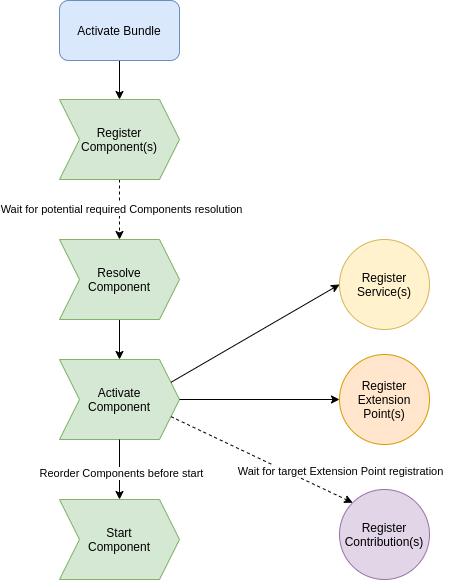Deployment Phases
The Nuxeo Platform deployment is incremental: the startup process involves different phases.
- Process Configuration Templates
- Process Deployment Fragment Resources
- Deploy Nuxeo Runtime Configurations and Bundles
- Initialize the Servlet Container
Configuration Templates Processing
The Configuration Template System is used to generate configuration files:
- data source declaration
- SMTP Gateway
- monitoring extensions
- misc extension point contributions (LDAP, SMTP, OpenOffice.org)
This is useful to define profile-like configurations, so that a given server can quickly be reconfigured for a given target environment:
- Dev profile
- Integration profile
- Production profile
- …
A template can be activated by creating a directory in the $NUXEO_HOME/templates directory: the corresponding directory name can then be used as an identifier and be listed in the nuxeo.templates variable, inside the $NUXEO_HOME/bin/nuxeo.conf file.
Some Nuxeo packages hold pre-computed templates, ready for activation.
The template directory usually holds Java property files with corresponding configuration variables and values. This variable can then be:
looked up in the application code
import org.nuxeo.runtime.api.Framework; [...] if (Framework.isBooleanPropertyTrue("my.service.enabled")) { // ... } String myProfileValue = Framework.getProperty("my.service.custom.variable");referenced by Nuxeo configurations
<component name="my.contrib"> <require>org.nuxeo.runtime.datasource.server.contrib</require> <extension target="org.nuxeo.runtime.datasource" point="datasources"> <datasource name="${nuxeo.db.commonds}" xaDataSource="${nuxeo.db.xadatasource}" maxTotal="${nuxeo.db["max-pool-size"]}" minTotal="${nuxeo.db["min-pool-size"]}" maxWaitMillis="${nuxeo.db["blocking-timeout-millis"]}" validationQuery="${nuxeo.db.validationQuery}" accessToUnderlyingConnectionAllowed="true" > </datasource> </extension> </component>The variable declaration can also hold a default value after the
:=marker:maxTotal="${nuxeo.db["max-pool-size"]}:=10"
The template directory can also hold XML configurations that represent Nuxeo Components. When the template is activated, these configurations will be deployed by the Runtime Framework, see below.
The template system can also use Freemarker to handle simple conditional processing:
...
<extension target="org.nuxeo.ecm.core.repository.RepositoryService"
point="repository">
<repository name="default"
factory="org.nuxeo.ecm.core.storage.sql.ra.PoolingRepositoryFactory">
<repository name="default">
<pool minPoolSize="${nuxeo.vcs["min-pool-size"]}" maxPoolSize="${nuxeo.vcs["max-pool-size"]}"
blockingTimeoutMillis="100" idleTimeoutMinutes="10" />
<#if "${nuxeo.core.binarymanager}" != "" >
<binaryManager class="${nuxeo.core.binarymanager}" />
</#if>
<clustering enabled="${repository.clustering.enabled}" delay="${repository.clustering.delay}" />
<binaryStore path="${repository.binary.store}" />
...
The file holding this configuration should be suffixed by .nxftl. This suffix will be removed when the Freemarker processing has been applied. For instance the file datasources-config.xml.nxftl will be renamed to datasources-config.xml.
Deployment Fragment Resources Processing
In Nuxeo, the target web application is generated from a group of separated bundles. Each bundle can contribute:
- resources to the WAR directory (JSP files, images, etc),
- contributions to the corresponding
web.xmlservlet file, - Java property files for i18n messages (translation files),
- …
To do that, you can place a file named deployment-fragment.xml in your jar inside the OSGI-INF directory.
This file can contain ANT-LIKE commands and XML contributions to the target templating file.
Sample contribution to the $NUXEO_HOME/nxserver/nuxeo.war/WEB-INF/web.xml file, using slot STD-AUTH-FILTER (check the file at $NUXEO_HOME/nxserver/META-INF/templates/web.xml for the complete list of slots)
<?xml version="1.0"?>
<fragment version="1">
<extension target="web#STD-AUTH-FILTER">
<filter-mapping>
<filter-name>NuxeoAuthenticationFilter</filter-name>
<url-pattern>/nxadmin/*</url-pattern>
<dispatcher>REQUEST</dispatcher>
<dispatcher>FORWARD</dispatcher>
</filter-mapping>
</extension>
</fragment>
Sample copy of the bundle web/nuxeo.war resources to the final $NUXEO_HOME/nxserver/nuxeo.war/ directory:
<?xml version="1.0"?>
<fragment version="1">
<install>
<unzip from="${bundle.fileName}" to="/" prefix="web">
<include>web/nuxeo.war/**</include>
</unzip>
</install>
</fragment>
Note that if you'd like to control the order in which this pre-processing is done, you can add a require tag in the fragment, naming the bundle that should be deployed before yours:
<?xml version="1.0"?>
<fragment version="1">
<require>org.nuxeo.ecm.platform.lang</require>
<install>
<delete path="${bundle.fileName}.tmp" />
<mkdir path="${bundle.fileName}.tmp" />
<unzip from="${bundle.fileName}" to="${bundle.fileName}.tmp" />
<append from="${bundle.fileName}.tmp/OSGI-INF/l10n/messages_en_US.properties"
to="nuxeo.war/WEB-INF/classes/messages.properties" addNewLine="true" />
<append from="${bundle.fileName}.tmp/OSGI-INF/l10n/messages_en_US.properties"
to="nuxeo.war/WEB-INF/classes/messages_en.properties" addNewLine="true" />
<append from="${bundle.fileName}.tmp/OSGI-INF/l10n/messages_en_US.properties"
to="nuxeo.war/WEB-INF/classes/messages_en_US.properties" addNewLine="true" />
<delete path="${bundle.fileName}.tmp" />
</install>
</fragment>
Nuxeo Runtime Configurations and Bundles Deployment
This phase deploys Nuxeo Runtime Components, registering Nuxeo Services, Extension Points and Contributions.
First, component XML files detected in the $NUXEO_HOME/nxserver/config/ directory are registered. These files might have been generated there thanks to the previous configuration templates processing.
NB: only files with a name ending with -config.xml will be taken into account.
Sometimes other resources are also present: they will be available in the classpath but will not be considered as component files.
After that, bundles are processed for components, following the Runtime Framework lifecycle:

In case of problems during the runtime deployment, the application startup might be aborted
(see --lenient option to control
that).
Sample startup log without errors:
INFO [OSGiRuntimeService] Nuxeo Platform Started
======================================================================
= Component Loading Status: Pending: 0 / Missing: 0 / Unstarted: 0 / Total: 548
======================================================================
Sample startup log with errors:
INFO [OSGiRuntimeService] Nuxeo Platform Started
======================================================================
= Component Loading Errors:
* Failed to load contributions for component service:OverridingXPoint-witherror
======================================================================
= Component Loading Status: Pending: 0 / Missing: 0 / Unstarted: 0 / Total: 12
======================================================================
To control the order in which components are deployed, you can add a <require> element at the start of a component definition: this component will be deployed after the required component has been deployed too.
This is useful to ensure proper override/merging behaviors on the final configuration held by the service.
Here are a few notes about it:
- a contribution does not need to require its target component: this requirement is implicit, and the contribution will only be registered when the target extension point has been registered.
- Studio bundles are deployed last: they require the
org.nuxeo.runtime.startedpseudo component, which is registered after all components have been resolved. - a failed requirement (requirement to a missing component) will prevent the server startup.
Servlet Container Initialization
Next, the Servlet Container is initialized, this is managed by Tomcat.
Servlets, filters, filter mappings are taken into account thanks to the previously-generated web.xml configuration.
Additional frameworks are also initialized (like the legacy JSF and Seam frameworks initializations, for instance).
At this point, the application is fully deployed and should be ready to serve external requests.
NuxeoCtl
NuxeoCtl is not really part of the deployment, but it's a central tool that helps managing Nuxeo startup and configuration.
NuxeoCtl provides:
- a Nuxeo Bootstrap
- runs the Configuration Template system
- starts the target Application Server
- some administration tools
- Nuxeo Package administration and installation
- start/stop/restart/configure/…
- a simple command GUI